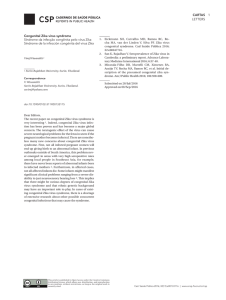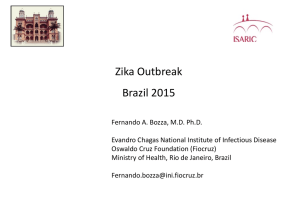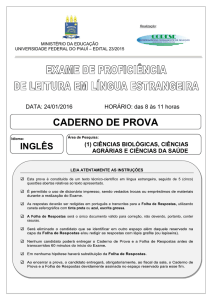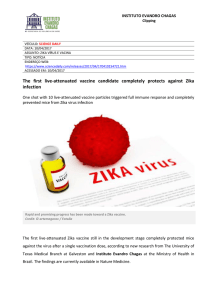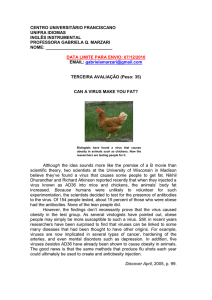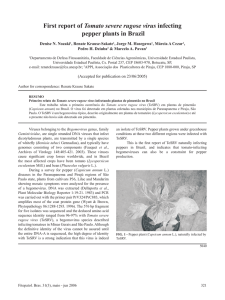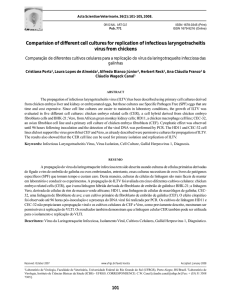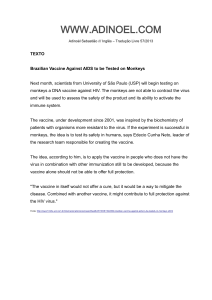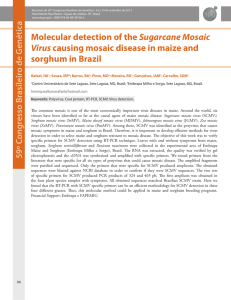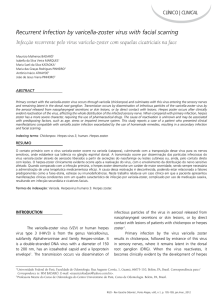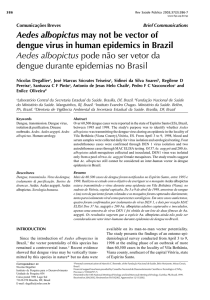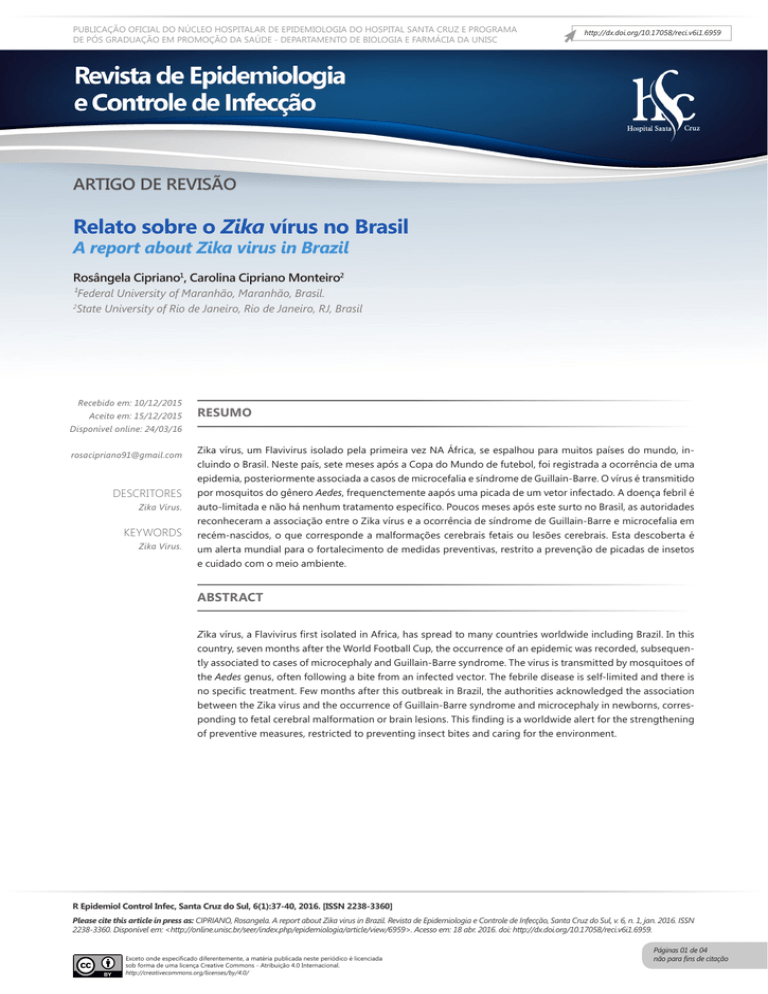
PUBLICAÇÃO OFICIAL DO NÚCLEO HOSPITALAR DE EPIDEMIOLOGIA DO HOSPITAL SANTA CRUZ E PROGRAMA
DE PÓS GRADUAÇÃO EM PROMOÇÃO DA SAÚDE - DEPARTAMENTO DE BIOLOGIA E FARMÁCIA DA UNISC
http://dx.doi.org/10.17058/reci.v6i1.6959
ARTIGO DE REVISÃO
Relato sobre o Zika vírus no Brasil
A report about Zika virus in Brazil
Rosângela Cipriano1, Carolina Cipriano Monteiro2
¹Federal University of Maranhão, Maranhão, Brasil.
2
State University of Rio de Janeiro, Rio de Janeiro, RJ, Brasil
Recebido em: 10/12/2015
Aceito em: 15/12/2015
RESUMO
Disponível online: 24/03/16
[email protected]
DESCRITORES
Zika Vírus.
KEYWORDS
Zika Virus.
Zika vírus, um Flavivirus isolado pela primeira vez NA África, se espalhou para muitos países do mundo, incluindo o Brasil. Neste país, sete meses após a Copa do Mundo de futebol, foi registrada a ocorrência de uma
epidemia, posteriormente associada a casos de microcefalia e síndrome de Guillain-Barre. O vírus é transmitido
por mosquitos do gênero Aedes, frequenctemente aapós uma picada de um vetor infectado. A doença febril é
auto-limitada e não há nenhum tratamento específico. Poucos meses após este surto no Brasil, as autoridades
reconheceram a associação entre o Zika vírus e a ocorrência de síndrome de Guillain-Barre e microcefalia em
recém-nascidos, o que corresponde a malformações cerebrais fetais ou lesões cerebrais. Esta descoberta é
um alerta mundial para o fortalecimento de medidas preventivas, restrito a prevenção de picadas de insetos
e cuidado com o meio ambiente.
ABSTRACT
Zika vírus, a Flavivirus first isolated in Africa, has spread to many countries worldwide including Brazil. In this
country, seven months after the World Football Cup, the occurrence of an epidemic was recorded, subsequently associated to cases of microcephaly and Guillain-Barre syndrome. The virus is transmitted by mosquitoes of
the Aedes genus, often following a bite from an infected vector. The febrile disease is self-limited and there is
no specific treatment. Few months after this outbreak in Brazil, the authorities acknowledged the association
between the Zika virus and the occurrence of Guillain-Barre syndrome and microcephaly in newborns, corresponding to fetal cerebral malformation or brain lesions. This finding is a worldwide alert for the strengthening
of preventive measures, restricted to preventing insect bites and caring for the environment.
R Epidemiol Control Infec, Santa Cruz do Sul, 6(1):37-40, 2016. [ISSN 2238-3360]
Please cite this article in press as: CIPRIANO, Rosangela. A report about Zika virus in Brazil. Revista de Epidemiologia e Controle de Infecção, Santa Cruz do Sul, v. 6, n. 1, jan. 2016. ISSN
2238-3360. Disponível em: <http://online.unisc.br/seer/index.php/epidemiologia/article/view/6959>. Acesso em: 18 abr. 2016. doi: http://dx.doi.org/10.17058/reci.v6i1.6959.
Exceto onde especificado diferentemente, a matéria publicada neste periódico é licenciada
sob forma de uma licença Creative Commons - Atribuição 4.0 Internacional.
http://creativecommons.org/licenses/by/4.0/
Páginas 01 de 04
não para fins de citação
A REPORT ABOUT ZIKA VIRUS IN BRAZIL
Rosângela Cipriano, Carolina Cipriano Monteiro.
INTRODUCTION
In the past three years, several emergent diseases - including vector-transmitted diseases, such
as arboviruses - were noticed as increasing around
the world, especially because of climate changes
as well as globalization of travel and trade. These
diseases include those caused by the Flaviviridae
Family, which comprises over 70 different members and
includes the Dengue virus, the Japanese Encephalitis
virus and the Yellow Fever virus.1-3 There are serological evidences that the Zika virus first isolated in Africa,
has spread to Asia since 1966.3 Few human cases were
reported until 2007, when a Zika fever epidemic took
place in Micronesia. Some major outbreaks were then
described in Thailand in 2012-2014. In that country, it is
now considered widespread.4 In December 2013, there
was a Zika virus outbreak in the French Polynesia and the
New Caledonia, when 396 laboratory-confirmed cases
occurred and an estimated 29,000 people sought medical care for suspected Zika illness. In that outbreak, 70
cases presented neurological or auto-immune complications.5 In 2013, the Zika virus had its complete coding
sequenced.6 However, at that time, Zika virus was not
described as a particular problem in Brazil.
According to the World Tourism Organization, over
1,1 billion tourists travelled abroad in 2014. In Brazil, there
were several international events with the arrival of large
numbers of people from various parts of the world.3,7 In
February 2015, seven months after the football world cup
was held in the country, the Ministry of Health in Brazil
registered the occurrence of a new viral febrile syndrome,
affecting mainly people between 20 and 40 years old.
This situation worsened, becoming a major public health
problem, mostly due to the suspected correlation between Zika and the microcephaly in newly born children,
as well as cases of the Guillain-Barre syndrome.
The virus and the vector
Zika is a mosquito-borne viral disease caused by
the Zika virus (ZIKAV), a flavivirus from the Flaviviridae
Family. Flaviviruses are RNA viruses that circulate in cycles
involving vertebrate hosts and insect vectors. It includes
multiple long known human, animal and zoonotic pathogens such as the Dengue virus, the Yellow fever virus, the
West Nilo virus and the Japanese encephalitis virus. 2 The
Zika virus was first isolated in 1947 from monkeys in the
Zika forest of Uganda.8
The transmission occurs via mosquito vectors from
the Aedes genus of the Culicidae Family in a sylvatic cycle
involving nonhuman primates. Many species of Aedes can
be involved in the transmission, such as A. africanus, A.
aegypti, A. albopictus and some other insects like Anopheles and Culex. The potential emergence of arboviruses in
a region depends on the mosquito vector presence and
the entry of people with the virus, often in an asymptomatic form. Human infection almost always follow the bite
of an infected tick or mosquito vectors.1,2,5
The virus was identified in urine, breast milk, saliva and semen, but the potential transmission by these
routes was not confirmed.3 In 2008 and 2013, some cases
probably associating prostatitis, with blood in semen and
sexual transmission by ZIKAV were related.9,10 Neonatal
infection is probably transmitted via the placenta or
during the delivery.7
According to latest studies, the epidermal keratinocytes and dendritic immature cells are susceptible to the
infection by ZIKV. The cutaneous fibroblastes infection
is associated to the production of viral particles and the
formation of autophagosomes.7 After the infection, the
virus invades the human cells and promotes an interaction with the endoplasmatic reticulum like a replication
platform, inducing a profound remodeling of its architecture and composition. It includes the activation and
rearrangement of cellular pathways related to this organelle which are connected with other relevant pathways
as apoptosis and innate immunity. 2 Pioneering studies
indicate the flaviviral replication complex as a promising
target for the development of antiviral compounds.11
Various members of the flavivirus have ability to gain
entry to the central nervous system - a process known
as viral neuroinvasiveness - and to infect neural cells - a
phenomenon known as neurovirulence. Both abilities
seem to be widely dispersed among various members
of the Flavivirus genes, which have a global distribution
range and suggest the existence of potential emergence
or more neurovirulent dengue strains.12 In a study held
in the 1970s, the neurotropism of the virus has been
demonstrated in experimental studies in mices.13
The disease
A substantial proportion of ZIKAV infections are
subclinical, and even the vast majority of patients are
asymptomatic. There are no pathognomonic signs. The
viruses generally cause a self-limiting illness, which most
common symptoms are the same reported to other
arboviral infections like dengue and chikungunya: low
grade fever, maculopapular rash, headache, non purulent
conjunctival suffusion, myalgia and joint pains.4,7 These
symptoms appear after an incubation period lasting
about four days. Until recently the disease was known
as not causing serious complications, rarely leading to
hospitalization or death. Rare cough and gastrointestinal
disorders like vomiting may occur. When compared to
other arboviruses - such as dengue fever, Zika causes
more rash and conjunctival hyperemia, and less laboratorial changes. Although the joint pain could persist for
a month, other symptoms may disappear after three to
seven days of its beginning.3
The laboratory alterations are mild and similar to
those found in other viruses. They are leucopenia, thrombocytopenia, elevation of serum lactic dehydrogenase
and inflammatory markers as C-reactive protein, fibrinogen and ferritin. The specific laboratory diagnosis is
based on detection of viral RNA from clinical specimens.
The viral isolation is only possible during the first four to
R Epidemiol Control Infec, Santa Cruz do Sul, 6(1):37-40, 2016. [ISSN 2238-3360]
Please cite this article in press as: CIPRIANO, Rosangela. A report about Zika virus in Brazil. Revista de Epidemiologia e Controle de Infecção, Santa Cruz do Sul,
v. 6, n. 1, jan. 2016. ISSN 2238-3360. Disponível em: <http://online.unisc.br/seer/index.php/epidemiologia/article/view/6959>. Acesso em: 18 abr. 2016. doi: http://
dx.doi.org/10.17058/reci.v6i1.6959.
Páginas 02 de 04
não para fins de citação
A REPORT ABOUT ZIKA VIRUS IN BRAZIL
Rosângela Cipriano, Carolina Cipriano Monteiro.
seven days from the onset of the symptoms, when the
viruses are circulating. After this period, the production
of IgM antibodies begin followed by the production of
IgG antibodies two weeks later.14,15
There is no specific treatment for ZIKAV infection.
For symptomatic patients it is recommended the use of
acetaminophen to control the fever and pain. Anti histamines can help to relieve itching. Anti-inflammatory and
acetylsalicylic acid should not be used, as well as in all
the infections caused by flaviviruses, due to the increased
risk of bleeding.3
The current outbreak in Brazil
Neurological and auto-immune complications were
reported in the outbreak occurred in the French Polynesia
in 2013.16 On 24 November 2015, the health authorities of
the French Polynesia reported an unusual increase of at
least 17 cases of central nervous system malformations
in fetuses and infants during 2014-2015, coinciding with
the Zika outbreaks on the island, including fetal cerebral
malformations or brain lesions, brainstem dysfunction
and absence of swallowing. None of the pregnant women described clinical signs of ZIKV infections, but the
four of them tested were found positive for flavivirus,
suggesting a possible asymptomatic ZIKV infection. It
was hypothesized that ZIKV infection may be associated
with these abnormalities if mothers are infected during
the first or second trimester of pregnancy.16
In Brazil, the introduction of the Zika virus was supposed to be started in the second half of 2014.3 And it was
confirmed in May 2015. Its spread was laboratory confirmed in 18 states, distributed in the five regions of the
country, featuring an outbreak.17 The outbreak peaked in
May with overall attack rate 5.5 cases/10,000 inhabitants.
In January 2016 there are laboratorial confirmed cases
in 20 states, involving almost all the country.18 Between
January and July 2015, 121 cases of neurological manifestations of the Guillain-Barré syndrome were notified
in several northeastern states with the record of previous
rash illness, raising the hypothesis of possible association
with ZIKAV infection.1,7
During the current outbreak in Brazil, the authorities
recognized the relationship between the Zika virus and
the occurrence of microcephaly outbreaks and deaths.19
3530 suspected cases of microcephaly identified in 724
municipalities of twenty-one states were reported in
Brazil until January 2016.18 The state of Pernambuco, the
first one to identify the rise of microcephaly, has held the
larger number of cases.19 This fact is unpublished in the
world medical literature and began a series of discussions
among experts to identify causes and define diagnosis
criteria. It was recorded an alteration in the pattern of occurrence of microcephaly with clear excess in the number
of cases in various parts of the northeast. The patterns
of suspected cases distribution of post infectious microcephaly presented dispersion characteristics. The first
three months of pregnancy of women with microcephalic
children correspond to a higher virus circulation period in
the Northeast region in Brazil. More than 60 women that
referred rash during the pregnancy had affected babies
without familiar genetic diseases. The Zika virus RNA was
identified in the amniotic fluid of two pregnant women
whose fetuses had microcephaly. Newly born children
that had had the diagnosis of microcephaly during the
pregnancy with positive results to Zika virus who died five
minutes after birth were also identified. It is known that
congenital malformations have complex and multifactorial etiology, but the current evidences strongly indicate
the relationship between Zika virus and microcephaly. 20
From these observations, the health authorities
have drawn protocols standardizing care, surveillance,
diagnostic criteria both clinical and laboratorial and routine care to pregnant women with probable Zika virus
infection. It also includes routine investigations for fetus
with central nervous system alterations probably related
to Zika virus during the pregnancy and spontaneous
From: National Program of Dengue Control (CGPNCD/DEVIT/SVS)18
Figure 1. States in Brazil with laboratorial confirmation of ZIKAV infection. 2015-2016.
R Epidemiol Control Infec, Santa Cruz do Sul, 6(1):37-40, 2016. [ISSN 2238-3360]
Please cite this article in press as: CIPRIANO, Rosangela. A report about Zika virus in Brazil. Revista de Epidemiologia e Controle de Infecção, Santa Cruz do Sul,
v. 6, n. 1, jan. 2016. ISSN 2238-3360. Disponível em: <http://online.unisc.br/seer/index.php/epidemiologia/article/view/6959>. Acesso em: 18 abr. 2016. doi: http://
dx.doi.org/10.17058/reci.v6i1.6959.
Páginas 03 de 04
não para fins de citação
A REPORT ABOUT ZIKA VIRUS IN BRAZIL
Rosângela Cipriano, Carolina Cipriano Monteiro.
abortion and stillbirth or newborn presenting microcephaly, probably related to Zika virus infection during the
pregnancy. This protocol also describes the occurrence
of the neurological syndrome related to ZIKAV, causing
Guillain-Barré or acute disseminated encephalomyelitis.
The objective of this protocol is to optimize the care of
affected persons and the prevention of new cases, in an
attempt to minimize damage and control this outbreak
which represents a serious public health problem in Brazil.20
The prevention is another challenge in this disease.
There is no vacccine to prevent ZIKAV disease. The most
importante form to prevent is by avoiding mosquito bites.
It is recommended the use of repellents, the wearing of
long-sleeved shirts and long pants and air conditioning
or window/door screens to keep mosquitoes outside.
Although mosquitoes may bite at any time of day, peak
biting activity for the vector is during daylight hours. It
is also very important to take care of the environment
to prevent the proliferation of mosquitoes by emptying
standing water from containers such as flowerpots or
buckets. 21 It is really a new moment to an old virus.
REFERENCES
1.
Sips GJ, Wilschut J, Smit JM. Neuroinvasive flavivirus infections.
Rev Med Virol 2012;22:69-87.
2.
Blázquez Ana-Belén et al. Stress responses in flavivirus-infected
cells: activation of unfloded protein response and autophagy.
Frontiers in Microbiology. Mini Review article published: 03
June 2014. doi: 10.3389/fmlcb.2014.00266.
3.
Ministério da Saúde (BR). Secretaria de Vigilância em Saúde –
Boletim epidemiológico – Volume 46 - nº 26, 2015 – Febre pelo
virus Zika: uma revisão narrativa sobre a doença
4.
Buathong R, et al. Detection of Zika Virus Infection in Thailand,
2012-2014. doi: doi/10.4269/ajtmh.15-0022
5.
European Centre for Disease Prevention and Contrl. Rapid risk
assessment: Zika virus infection outbreak, French Polynesia. 14
February 2014. Stockholm: ECDC;2014.
6.
Barontti C. Complete coding sequence of Zika virus from a
French Polynesia Outbreak in 2013. Genome Announc 2(3)
e00500-14. doi: 10.1128/genomeA.00500-14.
7.
Nham TX, Musso D. Émergence du virus Zika. Virologie 2015;19
(5):225-35
8.
Dick GWA, Kitchen SF, Haddow AJ. Zika virus. I. Isolations and
sorological specificity. Trans R Soc Trop Med Hyg 1952;46:50920. doi: 10.106/0035-9203(52)90042-4.
9.
Foy BD, Kobylinski KC, Chilson Foy JL, et al. Probable non-
vector-borne transmission of Zika virus, Colorado USA. Emerg
Infect Dis 2011;17:880-2.
10. Musso D, Roche C, Robin E, et al. Potencial Sexual Transmission
of Zika Virus. Emerging Infectious Disesases 2015;21:359-61.
www.cdc.gov/eid. doi: 10.3201/eid2102.141363.
11. Bollati M, et al. Structure and functionality in flaviviurs NSproteins: Perspectives for drug design. Antiviral Research 87
2010:125-148
12. GJ Sips, J Wilschut, JM Smit. Neuroinvasive flaviviurs infections.
Reviews in Medical Virology 2012;22:69-78
13. Bell TM, Field EJ, Narang HK. Zika Virus Infection of the Central
Nervous System of Mice. Archiv für die gesamte Virusforschung
1971;35:183-193.
14. Sullivan Nicolaides Pathology. Arbovirus Reports. Week
2(Ending 9/01/2016). Disponível em: http://www.snp.com.au/
media/507276/arbo_graph.pdf
15. Ministério da Saúde (BR). Dengue, Chikungunya e Zika. Exames
laboratoriais. Disponível em http://portalsaude.gov.br/index/
php/exames-laboratoriais-zika
16. European Centre for Disease Prevention and Control. Rapid risk
assessment: Zika virus infection outbreak, French Polynesia. 14
February 2014. Stockholm: ECDC; 2014
17. SVS/MS. NOTA À IMPRENSA – Confirmação do Zika Virus no
Brasil – 14 de maio de 2015 [Internet]. Brasilia: Ministério da
Saúde; 2015. Avaliable from: http://portalsaude.saude.gov.
br/index.php/o-ministerio/principal/secretarias/svs/noticiassvs/17702-confirmacao-do-zika-virus-no-brasil
18. Ministério da Saúde (BR). Informe epidemiológico nº 08 – semana
epidemiológica (SE) 01/2016 (03 a 09/01/2016) Monitoramento dos
casos de microcefalias no Brasil. Available from: http://portalsaude.
saude.gov.br/images/pdf/2016/janeiro/13/COES-Microcefalias
19. Ministério da Saúde (BR). Portal Brasil. Publicado 28/11/2015.
Ministério da Saúde confirma relação entre vírus zika e casos de
microcefalia. Available from: www.brasil.gov.br/saude/2015/11/
ministerio-da-saude-confirma-relacao-entre-virus-zika-emicrocefalia.
20. Ministério da Saúde (BR). Protocolo de vigilância e resposta
à ocorrência de microcefalia relacionada à infecção pelo
virus Zika – Plano Nacional de Enfrentamento à Microcefalia,
07/12/2015. Available from: http://portalsaude.saude.gov.br/
images/pdf/2015/dezembro/09/Microcefalia
21. CDC. Yellow Book. Health Information for International Travel,
2016, Chapter 2 (21) more. Roger S. Nasci, Robert A. Wirtz,
William G. Brogdon. The pre-Travel consultation. Protection
against Mosquitoes, Ticks and Other Arthropods. Available
from: wwwnc.cdc.gov/travel/page/yellowbook-home-2014
R Epidemiol Control Infec, Santa Cruz do Sul, 6(1):37-40, 2016. [ISSN 2238-3360]
Please cite this article in press as: CIPRIANO, Rosangela. A report about Zika virus in Brazil. Revista de Epidemiologia e Controle de Infecção, Santa Cruz do Sul,
v. 6, n. 1, jan. 2016. ISSN 2238-3360. Disponível em: <http://online.unisc.br/seer/index.php/epidemiologia/article/view/6959>. Acesso em: 18 abr. 2016. doi: http://
dx.doi.org/10.17058/reci.v6i1.6959.
Páginas 04 de 04
não para fins de citação

